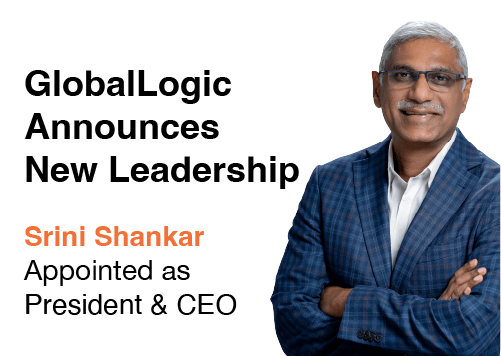- Послуги
Технологічні рішення
Технологічні рішення- Продуктова Стратегія та Дизайн Користувацького ДосвідуОкресліть створені програмним забезпеченням ланцюжки доданої вартості, створіть взаємодії, нові сегменти та пропозиції.
- Цифрова Трансформація БізнесуАдаптуйтесь, еволюціонуйте та зростайте у цифровому світі
- Інтелектуальна інженеріяВикористовуйте дані та АІ для трасформації продуктів, операційної діяльності та покращення бізнес результатів
- Розробка програмного забезпеченняПрискорте вихід на ринок продуктів, платформ та послуг.
- Технологічна МодернізаціяЗбільшуйте ефективність і гнучкість за допомогою модернізованих систем і застосунків.
- Вбудована інженерія та трансформація IT/OTСтворюйте та підтримуйте програмне забезпечення від чіпа до хмари для підключених пристроїв.
- Індустрії
- GlobalLogic VelocityAI
- Блоги
- Про нас
Press ReleaseGlobalLogicJanuary 10, 2025GlobalLogic оголошує про зміну керівництва: Сріні Шанкар ...
САНТА-КЛАРА, Каліфорнія — 10 січня 2025 року — Компанія GlobalLogic Inc., що є частиною...
 Press ReleaseGlobalLogicDecember 18, 2024
Press ReleaseGlobalLogicDecember 18, 2024GlobalLogic і Nokia стали партнерами для створення 5G-інновацій
GlobalLogic оголосила про партнерство з Nokia для прискорення впровадження передових 5G...

- Кар’єра
Published on May 9, 2024How does SDV change the automotive industry and what is the role of Ukraine in these changes
ПоділітьсяRelated Insights GlobalLogic17 February 2025
GlobalLogic17 February 2025 GlobalLogic12 February 2025Переглянути всю статистику
GlobalLogic12 February 2025Переглянути всю статистику GlobalLogic12 February 2025Recommended authorsAssociate Manager, Engineering, GlobalLogicLead Software Engineer, Engineering, GlobalLogicView all authorsSenior Manager, TAG Lead, GlobalLogic
GlobalLogic12 February 2025Recommended authorsAssociate Manager, Engineering, GlobalLogicLead Software Engineer, Engineering, GlobalLogicView all authorsSenior Manager, TAG Lead, GlobalLogicДавайте створювати інженерний вплив разом
GlobalLogic надає унікальний досвід і експертизу на перетині даних, дизайну та інжинірингу.
Зв'яжіться з намиCloudMobilityAuthor: Sergii Naida,
Vice President, Engineering, GlobalLogic UkraineSoftware-defined vehicles (SDVs) are changing the automotive industry and defining new industry standards. SDV Cloud Framework, the infrastructure concept developed by the GlobalLogic Ukraine team, is an important innovation in the automotive sector. It aims to create cloud infrastructure to optimize automotive software development and help to bring the user experience closer to the experience we have in smartphones — continuous product and capabilities updates throughout the vehicle’s lifecycle. Although cars are fundamentally more complex than phones, our infrastructure aims to provide automakers with relevant capabilities — efficient software development and testing, new features, and the ability to improve vehicles through continuous software updates.
Let’s consider the key aspects of SDV technologies and their impact on the automotive and try to understand how these changes will shape the future of the industry, what impact a solution of GlobalLogic engineers can make, and what opportunities this provides for the Ukrainian economy.
Software-Defined Vehicles — what is this trend and what are its benefits
According to a report by one of the largest consulting corporations, Deloitte, which referred to Software-Defined Vehicles as “the future industrial evolution.” – Cars, whose functionality is constantly improving and updating due to integrated software, define the development of the automotive industry over the next 5–10 years.
Over the past decade, the concept of Software-Defined Vehicles has evolved from an idea into a global industrial trend comparable to the digital transformation of recent years. Since 2012, when Tesla started implementing SDV solutions, dozens of leading OEMs have embraced this trend, including Renault, Mercedes, General Motors, Ford, Volvo Cars, and others.
The exponential growth of software in vehicles pushes a transformation into a service-oriented architecture similar to smartphones or personal computers. From Electronic Control Units responsible for specific functions or groups of functions in Distributed Architecture, we are transitioning to a single central computer – HPC (High-Performance Computer) and Zonal Architecture. The central computer and appropriate software applications will manage all vehicle functionality.
Both OEMs and drivers will benefit from this, though:
- increased safety level driven by collision prevention and driver assistance systems;
- enhanced comfort with smart integrated onboard infotainment systems, offering services such as video and music streaming and AI-based assistants;
- deeper understanding of the vehicle’s behavior and condition, leveraging remote diagnostics and telematics, allowing for more efficient predictive maintenance;
- for OEMs, this presents an opportunity to add new features through wireless updates, eliminating the need for drivers to visit service centers.
SDV Cloud Framework: faster development, efficient testing, and comfortable driving
The SDV Cloud Framework developed by GlobalLogic changes software development paradigms by leveraging new capabilities from cloud solution providers. This enables automakers to deploy updates more efficiently, streamline the process of enhancing vehicle software, and easily introduce new functions. Specialized applications for vehicle management through central computer enhance the convenience and functionality of automotive systems. A key advantage of this technology is the ability to use the same software across different car models, expanding the functional capabilities of vehicles throughout their lifetime. The SDV Cloud Framework provides a comprehensive infrastructure for development, integration, testing, and data analysis, improving products based on user behavior data.
GlobalLogic is one of the first five companies in the world that have presented ready-to-deploy solutions and listed them on the AWS and Azure marketplaces.
Today, automotive software is mostly tested on specialized equipment and real hardware. However, such an approach is expensive and requires significant resources and costly infrastructure. The existing approach imposes strong limitations because such systems are the biggest bottleneck of the testing and verification process. The SDV Cloud method leverages the ability of virtualization in the cloud (so-called Virtual SoC or Digital Twins), allowing the creation of virtual testing environments to check software components independently from the hardware. Virtualized testing is potentially capable of detecting over 90% of defects in the software components, which are crucial for testing speed and early engineer feedback.
The use of cloud technologies for development and testing can lead to a 30% reduction in software implementation costs and accelerate this process by up to 60%. For OEMs, such an approach simplifies the process of updating car software and provides the opportunity for user experience personalization through artificial intelligence. At the same time, improved efficiency and reduced time required for software development and testing significantly speed up the release of new vehicles.
Transformation of SDV: Economic Benefits and Opportunities for Ukraine
SDV trend creates promising opportunities. According to McKinsey, the compound annual growth rate (CAGR) of the SDV market is estimated at 9.4%. Meanwhile, research company Emergen Research indicates even higher CAGR figures, exceeding 19%. For instance, in the highly popular field of artificial intelligence (AI) development, this figure reaches around 20%. Boston Consulting Group and the World Economic Forum agree with a corresponding forecast, predicting that the SDV supplier market will double by 2030.
SDV will define the future of the automotive industry, where software becomes a key component of vehicles. This is a niche where Ukraine has extensive expertise and professionals who are among the first to offer unique solutions. Ukraine can become a key player in this trending niche if Ukraine engineers and experts will be able able to travel abroad, and showcase expertise, ideas, and products, to international clients. This can only contribute to the overall country’s economic growth.
Business in uncertain conditions
The great potential of the SDV trend opens up new horizons and opportunities for the Ukrainian economy, but along with them, we face challenges that require attention and resolution. Of course, if we want to catch this “train” and not miss the opportunity.
Currently, the limitations in Ukraine are quite obvious. First and foremost, this is the inability of specialists to travel abroad and participate in industry events. Such events are a significant component of the automotive business, which involves close and frequent networking with partners. For example, our team could not attend CES 2024 and present our SDV Cloud Framework in person. Since the SDV going through a very fast innovation pace, it is important to be at the epicenter of this innovation and to have constant dialogue with both clients and other market players. This is not always possible online. Many events require personal presence to exchange updates, experiences and ideas.
Furthermore, large companies fear doing business in Ukraine due to political, economic, and security uncertainty, particularly automotive OEMs. OEMs shape their plans very carefully and strategically. If they see significant risks in the country for the next 3-4 years, they may be willing to work with the company, but outside of Ukraine. Is this good for the Ukraine economy? This is a rhetorical question that brings us back to the first point. To attract clients, communication and personal meetings are necessary to explain, inspire, and sell.
Ukrainian engineers are already a significant contributor to software development for the automotive industry. However, due to limitations, we lose the opportunity to enter the global market and become one of the market leaders. Being deprived of the opportunity to participate in major industrial alliances and events limits our ability to stay up to date with the international market. Innovation can not happen without constant interaction with the market. And right now, we are limited from interacting with it properly.

